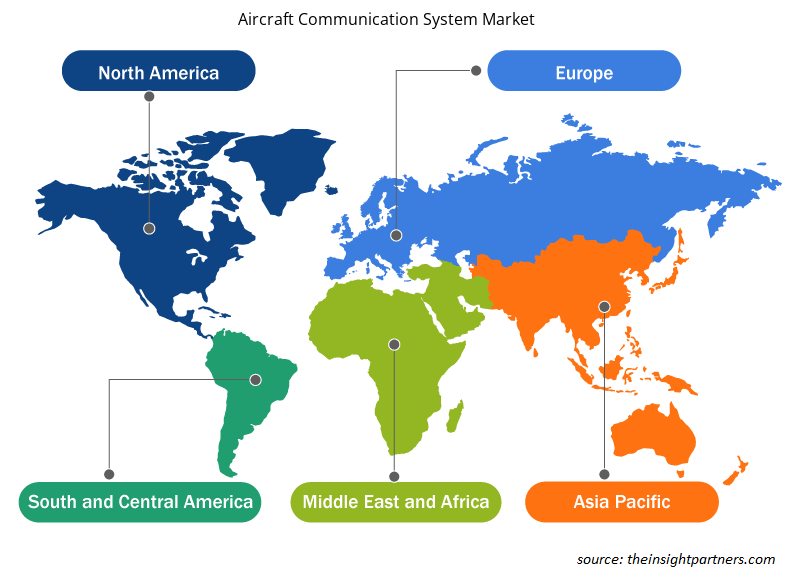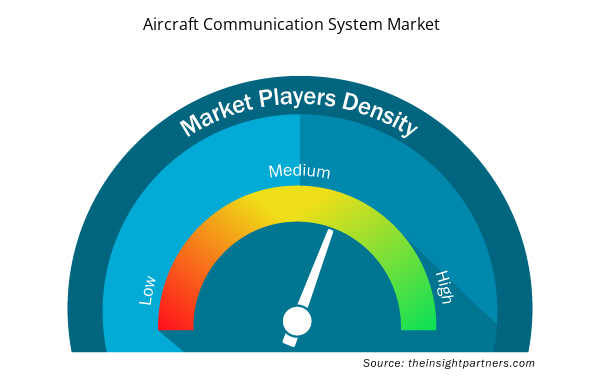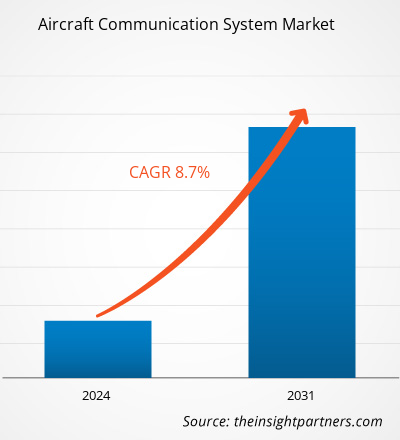Der Markt für Flugzeugkommunikationssysteme soll von 8,61 Milliarden US-Dollar im Jahr 2023 auf 16,77 Milliarden US-Dollar im Jahr 2031 anwachsen. Der Markt soll in den Jahren 2023–2031 eine durchschnittliche jährliche Wachstumsrate von 8,7 % verzeichnen. Die wachsende Nachfrage nach Echtzeitinformationen, Datenaustausch und Konnektivität ist ein wichtiger Antriebsfaktor für den weltweiten Markt für Flugzeugkommunikationssysteme. Die zunehmende Einführung von High-End-Kommunikationssystemen wie SATCOM verbessert das Passagiererlebnis und das Flugverkehrsmanagement, was ebenfalls ein wichtiger Antriebsfaktor für den weltweiten Markt für Flugzeugkommunikationssysteme ist.
Marktanalyse für Flugzeugkommunikationssysteme
Flugzeugkommunikationssysteme werden hauptsächlich für den Datenaustausch, die Sprachübertragung, den Echtzeit-Informationsaustausch und den Empfang zwischen Flugzeugen oder Bodenstationen genutzt. Die Flugzeugkommunikationssysteme verbessern die Erfahrung der satellitengestützten Navigationsüberwachung, was sich positiv auf das Wachstum des Flugzeugkommunikationsmarktes auswirkt. Meistens implementieren Anbieter auf dem Flugzeugkommunikationsmarkt fortschrittliche Technologien wie Flugverkehrsmanagement durch drahtlose Kommunikationstechnologien und Hochgeschwindigkeitsverbindungsbahnen. Diese großen Anbieter von Flugzeugkommunikationssystemen investieren erheblich in ihre Forschungs- und Entwicklungsaktivitäten, um technologisch verbesserte Kommunikationssysteme für militärische und kommerzielle Flotten herzustellen, was die Entwicklung des Flugzeugkommunikationssystemmarktes im Prognosezeitraum voraussichtlich vorantreiben wird.
Marktübersicht für Flugzeugkommunikationssysteme
Der technologische Fortschritt in der Luftfahrtelektronik, der Kommunikationsinfrastruktur und der Managementkontrollsysteme hat große Auswirkungen auf die Entwicklung des Marktes für Flugzeugkommunikation. Die Flugzeugkommunikation hat die Zahl der Flugunfälle erheblich verringert und das Kommunikationsnetz in Notfällen verbessert. Darüber hinaus wird erwartet, dass der Aufwärtstrend bei satellitengestützten Navigationssystemen zur Verkürzung der Flugzeit und zur Verkürzung der Komplexität des Flugverkehrsmanagements das Wachstum des Marktes für Flugzeugkommunikationssysteme ankurbeln wird.
Passen Sie diesen Bericht Ihren Anforderungen an
Sie erhalten kostenlos individuelle Anpassungen an jedem Bericht, einschließlich Teilen dieses Berichts oder einer Analyse auf Länderebene, eines Excel-Datenpakets sowie tolle Angebote und Rabatte für Start-ups und Universitäten.
- Holen Sie sich die wichtigsten Markttrends aus diesem Bericht.Dieses KOSTENLOSE Beispiel umfasst eine Datenanalyse von Markttrends bis hin zu Schätzungen und Prognosen.
Markttreiber und Chancen für Flugzeugkommunikationssysteme
Die zunehmende Nutzung der Satellitenkommunikation dürfte der Haupttreiber für den Markt für Flugzeugkommunikationssysteme sein
Der wachsende technologische Fortschritt in der Luftfahrtindustrie fördert die Anwendung satellitengestützter Kommunikationsinfrastruktur. Die Verbreitung von Software Defined Radio zum Aufbau von Satellitenkommunikationsnetzen ist ein wichtiger Treiber für den Markt für Flugzeugkommunikationssysteme. Die Satellitenkommunikationsinfrastruktur umfasst eine breite Palette von Netzwerktechnologien für bequeme und reibungslose Konnektivitätsdienste zwischen Flotte und Bodenpersonal. Die Flexibilität und die Hochgeschwindigkeitsverbindung treiben die Nachfrage nach Satellitenkommunikationssystemen an, die wiederum ein wichtiger Antriebsfaktor für den Markt für Flugzeugkommunikationssysteme weltweit sind.
Steigende Ausgaben der Fluggesellschaften für Bordkommunikationssysteme
Die Flugzeughersteller konzentrieren sich auf die Integration hochentwickelter Kommunikationssysteme für ein besseres Betriebsmanagement. Die hochentwickelten Flugzeugkommunikationssysteme helfen dabei, in Notfällen bequem eine ordnungsgemäße Verbindung zwischen Flugzeug und Bodenbasis herzustellen. Darüber hinaus verringern sie auch das Risiko von Flugzeugunfällen. Der Austausch von Echtzeitdaten zu Flugzeiten, Position, Zustand und Steuerung ist ein wichtiges Merkmal von Flugzeugkommunikationssystemen. Bei Verkehrsflugzeugen ist die Kommunikation zwischen Pilot und Bodenpersonal zum Zeitpunkt des Starts und der Landung von entscheidender Bedeutung. Darüber hinaus tauschen Militär- oder Verteidigungsflugzeuge auch wichtige Informationen zu Missionen aus, wie z. B. Zielposition, Treibstoffstatus, Flottenstandort und kritische missionsbezogene Informationen. Die wachsende Bedeutung von Kommunikationsnetzwerken im Luftfahrtsektor wird voraussichtlich das Wachstum des Marktes für Flugzeugkommunikationssysteme im Prognosezeitraum vorantreiben.
Segmentierungsanalyse des Marktberichts für Flugzeugkommunikationssysteme
Wichtige Segmente, die zur Ableitung der Marktanalyse für Flugzeugkommunikationssysteme beigetragen haben, sind Typ, Komponenten und Flugzeugtyp.
- Basierend auf dem Typ wurde der Markt für Flugzeugkommunikationssysteme in VHF/UHF/HF-Funkgeräte, Datenverbindungen und SATCOM unterteilt. Das Segment VHF/UHF/HF-Funkgeräte hatte im Jahr 2023 einen größeren Marktanteil.SATCOM. The VHF/UHF/HF Radios segment held a larger market share in 2023.
- In Bezug auf die Komponenten wurde der Markt in Antennen, Transponder, Transceiver sowie Displays und Prozessoren segmentiert. Das Transpondersegment dominierte den Markt im Jahr 2023.
- In Bezug auf den Flugzeugtyp wurde der Markt in Verkehrsflugzeuge und Militärflugzeuge segmentiert. Die kommerziellen Segmente dominierten den Markt im Jahr 2023.
Marktanteilsanalyse für Flugzeugkommunikationssysteme nach Geografie
Der geografische Umfang des Marktberichts über Flugzeugkommunikationssysteme ist hauptsächlich in fünf Regionen unterteilt: Nordamerika, Europa, Asien-Pazifik, Naher Osten und Afrika sowie Südamerika.
Nordamerika war im Jahr 2023 Marktführer auf dem Markt für Flugzeugkommunikationssysteme. Die Region Nordamerika umfasst die USA, Kanada und Mexiko. Hohe Investitionen in fortschrittliche Technologien und drahtlose Konnektivität für den Flugsektor wirken als Haupttreiber für den Markt. Die hohe Präsenz von Fluggesellschaften und großen Herstellern von Flugzeugkommunikationssystemen treibt auch das Wachstum des Marktes für Flugzeugkommunikationssysteme in Nordamerika voran. Zunehmende Forschungs- und Entwicklungsaktivitäten im Luftfahrtsektor zur Verbesserung der Funktionen von Verkehrs- und Verteidigungsflugzeugen für eine verbesserte Kommunikationsinfrastruktur treiben das Wachstum des Marktes für kommerzielle Flugzeugsysteme in Nordamerika voran.
Regionale Einblicke in den Markt für Flugzeugkommunikationssysteme
Die regionalen Trends und Faktoren, die den Markt für Flugzeugkommunikationssysteme im Prognosezeitraum beeinflussen, wurden von den Analysten von Insight Partners ausführlich erläutert. In diesem Abschnitt werden auch die Marktsegmente und die Geografie von Flugzeugkommunikationssystemen in Nordamerika, Europa, im asiatisch-pazifischen Raum, im Nahen Osten und Afrika sowie in Süd- und Mittelamerika erörtert.

- Erhalten Sie regionale Daten zum Markt für Flugzeugkommunikationssysteme
Umfang des Marktberichts für Flugzeugkommunikationssysteme
| Berichtsattribut | Details |
|---|---|
| Marktgröße im Jahr 2023 | 8,61 Milliarden US-Dollar |
| Marktgröße bis 2031 | 16,77 Milliarden US-Dollar |
| Globale CAGR (2023 - 2031) | 8,7 % |
| Historische Daten | 2021-2022 |
| Prognosezeitraum | 2024–2031 |
| Abgedeckte Segmente | Nach Typ
|
| Abgedeckte Regionen und Länder | Nordamerika
|
| Marktführer und wichtige Unternehmensprofile |
|
Dichte der Marktteilnehmer für Flugzeugkommunikationssysteme: Auswirkungen auf die Geschäftsdynamik verstehen
Der Markt für Flugzeugkommunikationssysteme wächst rasant, angetrieben durch die steigende Nachfrage der Endnutzer aufgrund von Faktoren wie sich entwickelnden Verbraucherpräferenzen, technologischen Fortschritten und einem größeren Bewusstsein für die Vorteile des Produkts. Mit steigender Nachfrage erweitern Unternehmen ihr Angebot, entwickeln Innovationen, um die Bedürfnisse der Verbraucher zu erfüllen, und nutzen neue Trends, was das Marktwachstum weiter ankurbelt.
Die Marktteilnehmerdichte bezieht sich auf die Verteilung von Firmen oder Unternehmen, die in einem bestimmten Markt oder einer bestimmten Branche tätig sind. Sie gibt an, wie viele Wettbewerber (Marktteilnehmer) in einem bestimmten Marktraum im Verhältnis zu seiner Größe oder seinem gesamten Marktwert präsent sind.
Die wichtigsten auf dem Markt für Flugzeugkommunikationssysteme tätigen Unternehmen sind:
- Honeywell International Inc
- Northrop Grumman Corporation
- General Dynamics Corporation
- L3Harris Technologies Inc
- Cobham Plc
- Thales-Gruppe
Haftungsausschluss : Die oben aufgeführten Unternehmen sind nicht in einer bestimmten Reihenfolge aufgeführt.

- Überblick über die wichtigsten Akteure auf dem Markt für Flugzeugkommunikationssysteme
Nachrichten und aktuelle Entwicklungen zum Markt für Flugzeugkommunikationssysteme
Der Markt für Flugzeugkommunikationssysteme wird durch die Erfassung qualitativer und quantitativer Daten nach Primär- und Sekundärforschung bewertet, die wichtige Unternehmensveröffentlichungen, Verbandsdaten und Datenbanken umfasst. Im Folgenden finden Sie eine Liste der Entwicklungen auf dem Markt für Flugzeugkommunikationssysteme und Strategien:
- Im August 2023 schloss die Northrop Grumman Corporation in Zusammenarbeit mit der US Air Force eine Demonstration des integrierten luftgestützten Missionstransfers (IAMT) mit der B-2 Spirit auf der Whiteman Air Force Base ab. (Quelle: Northrop Grumman Corporation, Pressemitteilung/Unternehmenswebsite/Newsletter)
- Im April 2024 übernahm die Thales Group Cobham Aerospace Communications, um ihre Position im Bereich der Cockpit-Sicherheitskommunikation zu stärken. (Quelle: Thales Group, Pressemitteilung/Unternehmenswebsite/Newsletter)
Marktbericht zu Flugzeugkommunikationssystemen – Umfang und Ergebnisse
Der Bericht „Marktgröße und Prognose für Flugzeugkommunikationssysteme (2021–2031)“ bietet eine detaillierte Analyse des Marktes, die die folgenden Bereiche abdeckt:
- Marktgröße und Prognose auf globaler, regionaler und Länderebene für alle wichtigen Marktsegmente, die im Rahmen des Projekts abgedeckt sind
- Marktdynamik wie Treiber, Beschränkungen und wichtige Chancen
- Wichtige Zukunftstrends
- Detaillierte PEST-Analyse
- Globale und regionale Marktanalyse mit wichtigen Markttrends, wichtigen Akteuren, Vorschriften und aktuellen Marktentwicklungen
- Branchenlandschaft und Wettbewerbsanalyse, einschließlich Marktkonzentration, Heatmap-Analyse, prominenten Akteuren und aktuellen Entwicklungen
- Detaillierte Firmenprofile mit SWOT-Analyse
- Historische Analyse (2 Jahre), Basisjahr, Prognose (7 Jahre) mit CAGR
- PEST- und SWOT-Analyse
- Marktgröße Wert/Volumen – Global, Regional, Land
- Branche und Wettbewerbsumfeld
- Excel-Datensatz


- Electronic Health Record Market
- Skin Graft Market
- Third Party Logistics Market
- Excimer & Femtosecond Ophthalmic Lasers Market
- Adaptive Traffic Control System Market
- Small Molecule Drug Discovery Market
- Rare Neurological Disease Treatment Market
- Tortilla Market
- Procedure Trays Market
- Railway Braking System Market

Report Coverage
Revenue forecast, Company Analysis, Industry landscape, Growth factors, and Trends

Segment Covered
This text is related
to segments covered.

Regional Scope
North America, Europe, Asia Pacific, Middle East & Africa, South & Central America

Country Scope
This text is related
to country scope.
Trends and growth analysis reports related to Aerospace and Defense : READ MORE..
The Insight Partners performs research in 4 major stages: Data Collection & Secondary Research, Primary Research, Data Analysis and Data Triangulation & Final Review.
- Data Collection and Secondary Research:
As a market research and consulting firm operating from a decade, we have published and advised several client across the globe. First step for any study will start with an assessment of currently available data and insights from existing reports. Further, historical and current market information is collected from Investor Presentations, Annual Reports, SEC Filings, etc., and other information related to company’s performance and market positioning are gathered from Paid Databases (Factiva, Hoovers, and Reuters) and various other publications available in public domain.
Several associations trade associates, technical forums, institutes, societies and organization are accessed to gain technical as well as market related insights through their publications such as research papers, blogs and press releases related to the studies are referred to get cues about the market. Further, white papers, journals, magazines, and other news articles published in last 3 years are scrutinized and analyzed to understand the current market trends.
- Primary Research:
The primarily interview analysis comprise of data obtained from industry participants interview and answers to survey questions gathered by in-house primary team.
For primary research, interviews are conducted with industry experts/CEOs/Marketing Managers/VPs/Subject Matter Experts from both demand and supply side to get a 360-degree view of the market. The primary team conducts several interviews based on the complexity of the markets to understand the various market trends and dynamics which makes research more credible and precise.
A typical research interview fulfils the following functions:
- Provides first-hand information on the market size, market trends, growth trends, competitive landscape, and outlook
- Validates and strengthens in-house secondary research findings
- Develops the analysis team’s expertise and market understanding
Primary research involves email interactions and telephone interviews for each market, category, segment, and sub-segment across geographies. The participants who typically take part in such a process include, but are not limited to:
- Industry participants: VPs, business development managers, market intelligence managers and national sales managers
- Outside experts: Valuation experts, research analysts and key opinion leaders specializing in the electronics and semiconductor industry.
Below is the breakup of our primary respondents by company, designation, and region:

Once we receive the confirmation from primary research sources or primary respondents, we finalize the base year market estimation and forecast the data as per the macroeconomic and microeconomic factors assessed during data collection.
- Data Analysis:
Once data is validated through both secondary as well as primary respondents, we finalize the market estimations by hypothesis formulation and factor analysis at regional and country level.
- Macro-Economic Factor Analysis:
We analyse macroeconomic indicators such the gross domestic product (GDP), increase in the demand for goods and services across industries, technological advancement, regional economic growth, governmental policies, the influence of COVID-19, PEST analysis, and other aspects. This analysis aids in setting benchmarks for various nations/regions and approximating market splits. Additionally, the general trend of the aforementioned components aid in determining the market's development possibilities.
- Country Level Data:
Various factors that are especially aligned to the country are taken into account to determine the market size for a certain area and country, including the presence of vendors, such as headquarters and offices, the country's GDP, demand patterns, and industry growth. To comprehend the market dynamics for the nation, a number of growth variables, inhibitors, application areas, and current market trends are researched. The aforementioned elements aid in determining the country's overall market's growth potential.
- Company Profile:
The “Table of Contents” is formulated by listing and analyzing more than 25 - 30 companies operating in the market ecosystem across geographies. However, we profile only 10 companies as a standard practice in our syndicate reports. These 10 companies comprise leading, emerging, and regional players. Nonetheless, our analysis is not restricted to the 10 listed companies, we also analyze other companies present in the market to develop a holistic view and understand the prevailing trends. The “Company Profiles” section in the report covers key facts, business description, products & services, financial information, SWOT analysis, and key developments. The financial information presented is extracted from the annual reports and official documents of the publicly listed companies. Upon collecting the information for the sections of respective companies, we verify them via various primary sources and then compile the data in respective company profiles. The company level information helps us in deriving the base number as well as in forecasting the market size.
- Developing Base Number:
Aggregation of sales statistics (2020-2022) and macro-economic factor, and other secondary and primary research insights are utilized to arrive at base number and related market shares for 2022. The data gaps are identified in this step and relevant market data is analyzed, collected from paid primary interviews or databases. On finalizing the base year market size, forecasts are developed on the basis of macro-economic, industry and market growth factors and company level analysis.
- Data Triangulation and Final Review:
The market findings and base year market size calculations are validated from supply as well as demand side. Demand side validations are based on macro-economic factor analysis and benchmarks for respective regions and countries. In case of supply side validations, revenues of major companies are estimated (in case not available) based on industry benchmark, approximate number of employees, product portfolio, and primary interviews revenues are gathered. Further revenue from target product/service segment is assessed to avoid overshooting of market statistics. In case of heavy deviations between supply and demand side values, all thes steps are repeated to achieve synchronization.
We follow an iterative model, wherein we share our research findings with Subject Matter Experts (SME’s) and Key Opinion Leaders (KOLs) until consensus view of the market is not formulated – this model negates any drastic deviation in the opinions of experts. Only validated and universally acceptable research findings are quoted in our reports.
We have important check points that we use to validate our research findings – which we call – data triangulation, where we validate the information, we generate from secondary sources with primary interviews and then we re-validate with our internal data bases and Subject matter experts. This comprehensive model enables us to deliver high quality, reliable data in shortest possible time.


 Holen Sie sich ein kostenloses Muster für diesen Bericht
Holen Sie sich ein kostenloses Muster für diesen Bericht